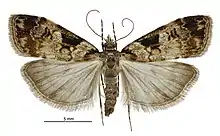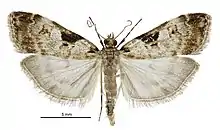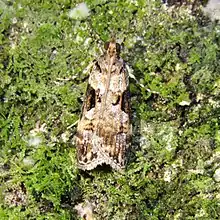Scoparia acharis
Scoparia acharis is a moth of the family Crambidae.[3] It was named by Edward Meyrick in 1884. This species is endemic to New Zealand and has been observed in both the North and South Islands. The preferred habitat of this species is native forest and in the South Island S. acharis has been observed in beech forest. The larval host of this species is moss. Adults are most commonly on the wing from November to January, although this species has been observed from October until March.
| Scoparia acharis | |
|---|---|
 | |
| Female | |
 | |
| Male | |
| Scientific classification | |
| Domain: | Eukaryota |
| Kingdom: | Animalia |
| Phylum: | Arthropoda |
| Class: | Insecta |
| Order: | Lepidoptera |
| Family: | Crambidae |
| Genus: | Scoparia |
| Species: | S. acharis |
| Binomial name | |
| Scoparia acharis | |
Taxonomy
This species was first mentioned by Edward Meyrick in 1884 and in May 1885 was given a fuller description.[4][5] For this description Meyrick used two specimens collected at Akaroa and Dunedin amongst native forest in January.[5] In 1928 George Hudson discussed and illustrated this species in his publication The butterflies and moths of New Zealand.[6] The male lectotype, collected in Akaroa, is held at the Natural History Museum, London.[7]
Description

The eggs of this species are oval in shape and are laid flat in groups of two or three. The egg is approximately 0.4 mm in length and is green in colour with an iridescent sheen. The surface is ridged and roughened.[6]
The wingspan is 17.5 mm. The forewings are whitish-ochreous, irrorated with fuscous and dark fuscous. There is a sharply defined oblique black spot from the base of the costa. The first line is indicated only by an obscure dark posterior margin, followed on the costa by a sharply-defined moderate triangular black spot. The terminal area is suffused with brownish-ochreous and there is a cloudy, ochreous-whitish subterminal line with a row of ochreous-whitish marks. The hindwings are very pale whitish grey.[5]
This species is distinctive in appearance with sharply defined black costal markings, double reniform and relatively long antennal ciliations.[5]
Distribution
This species is endemic to New Zealand.[1] It has been observed throughout the North and South Islands including at Kaeo, Ohakune, in the Tararua Ranges, Kaitoke, Wellington, Akaroa, Otira, Dunedin, Lake Wakatipu, and Invercargill.[6][8][9]
Habitat
This species inhabits native forest.[6] S. acharis has also be observed in beech forest at Mt Aspiring Station where the species is restricted to alpine habitat.[10] The larval host of this species is moss.[11]
Behaviour
Adults have most commonly been recorded on wing from November to January, although this species has been observed from October until March.[12][13] This species is attracted to light.[14][11]
References
- "Scoparia acharis Meyrick, 1884". www.nzor.org.nz. Retrieved 27 January 2018.
- "Scoparia acharis Meyrick, 1884". biotanz.landcareresearch.co.nz. Retrieved 2023-04-10.
- Gordon, Dennis P., ed. (2010). New Zealand inventory of biodiversity: Kingdom animalia : chaetognatha, ecdysozoa, ichnofossils. Vol. 2. p. 458. ISBN 978-1-877257-93-3. OCLC 973607714. OL 25288394M. Wikidata Q45922947.
- Edward Meyrick (1884). "Descriptions of New Zealand Microlepidoptera. IV. Scopariadae". New Zealand Journal of Science. 2: 235. Wikidata Q113372586.
- Edward Meyrick (1885). "Art. XI. — Descriptions of New Zealand Micro-Lepidoptera". Transactions and Proceedings of the New Zealand Institute. 17: 85–86. ISSN 1176-6158. Wikidata Q113379604.
 This article incorporates text from this source, which is in the public domain.
This article incorporates text from this source, which is in the public domain. - George Vernon Hudson (1928), The butterflies and moths of New Zealand, Illustrator: George Hudson, Wellington, p. 186, LCCN 88133764, OCLC 25449322, Wikidata Q58593286
{{citation}}: CS1 maint: location missing publisher (link) - John Stewart Dugdale (23 September 1988). "Lepidoptera - annotated catalogue, and keys to family-group taxa". Fauna of New Zealand. Department of Scientific and Industrial Research. 14: 159. doi:10.7931/J2/FNZ.14. ISSN 0111-5383. Wikidata Q45083134.
- George Vernon Hudson (June 1905). "Notes on the Entomology of Mount Holdsworth, Tararua Range". Transactions and Proceedings of the New Zealand Institute. 37: 340. ISSN 1176-6158. Wikidata Q117490692.
- George Vernon Hudson (June 1913). "Notes on the Entomology of the Ohakune and Waiouru Districts". Transactions and Proceedings of the New Zealand Institute. 45: 61. ISSN 1176-6158. Wikidata Q117491464.
- Mt Aspiring Station-Conservation Resources Report pt1 (PDF) (Report). Land Information New Zealand Ltd. November 2005. pp. 1–96. Retrieved 15 June 2018.
- Esperschuetz, Juergen (2018). Restoration research - Punakaiki Coastal Restoration Project, 2014-2016 (PDF). Mike Bowie, Carol M.S. Smith, Mick Abbott, Nicholas M. Dickinson, Lincoln University. Department of Ecology. [Christchurch]: Lincoln University. p. 84. ISBN 978-0-86476-418-8. OCLC 1204405272.
- Alfred Philpott (1917). "A list of the Lepidoptera of Otago". Transactions and Proceedings of the New Zealand Institute. 49: 219. ISSN 1176-6158. Wikidata Q63958657.
- "Scoparia acharis: iNaturalist Research Grade Observations". iNaturalist. Retrieved 2023-04-10.
- D. E. Gaskin (January 1970). "NEW RECORDS OF LEPIDOPTERA FROM MT. EGMONT AND MT. RUAPEHU, NEW ZEALAND". New Zealand Entomologist. 4 (3): 113. doi:10.1080/00779962.1970.9722933. ISSN 0077-9962. Wikidata Q105726524.